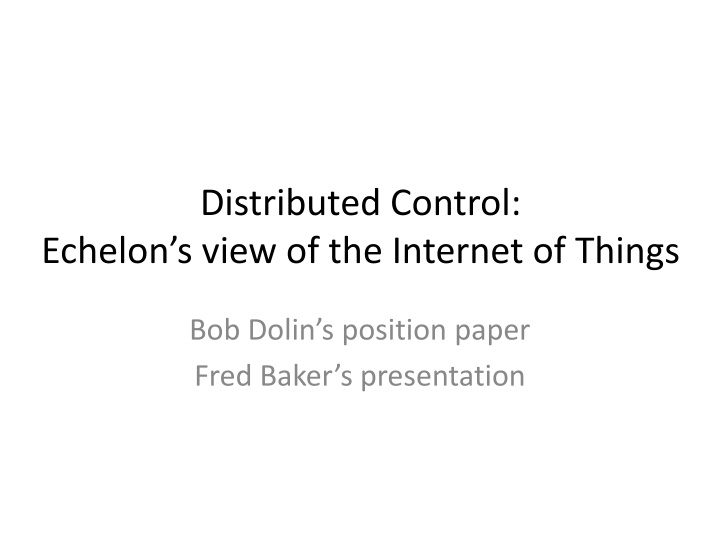
Distributed Control in the Internet of Things: Types and Examples
Explore distributed control concepts in the Internet of Things, including real-time communication types, network stack requirements, and examples like ANSI/CEA 709.1 and the Bellagio Fountain. Understand the importance of timely retransmission, emergency message handling, and the paradigm shift towards peer-to-peer communication.
Download Presentation

Please find below an Image/Link to download the presentation.
The content on the website is provided AS IS for your information and personal use only. It may not be sold, licensed, or shared on other websites without obtaining consent from the author. If you encounter any issues during the download, it is possible that the publisher has removed the file from their server.
You are allowed to download the files provided on this website for personal or commercial use, subject to the condition that they are used lawfully. All files are the property of their respective owners.
The content on the website is provided AS IS for your information and personal use only. It may not be sold, licensed, or shared on other websites without obtaining consent from the author.
E N D
Presentation Transcript
Distributed Control: Echelon s view of the Internet of Things Bob Dolin s position paper Fred Baker s presentation
Distributed control in the Internet of Things Types of real time in communications Normal Internet communications Moving files, exchanging text, in a static network Human time scales, nobody dies if something is late Space: Command/Telemetry Constant feedback, occasional configuration changes Remote object time scales, nobody dies if something is late Distributed Control machine to machine Continuously changing variables to control the behavior of an application In some applications, people die, or are annoyed, or the purpose is not served if time scales of interest are not observed
Example of distributed control: ANSI/CEA 709.1, EN-14908-1, GB/Z 20177.1 Bellagio Fountain http://www.5min.com/Video/Learn-About-the-Bellagio-Fountains-278834664 Numerous control points Sometimes addressed as a group Sometimes addressed individually Paradigm: Central controller sets variables Actions are published as status Status changes published on a node affect the actions of the nodes that are subscribed to the status change NACKs May be appropriate for scaling when moving large amounts of data Positive Acknowledgement Need for commands Retransmission within loss variance
Network stack requirements (assumptions made by application) #1 Retransmission: Network recovers from packet loss or informs application Recovery is timely: on the order of RTTs, not seconds Network engineering meets application requirements Network independent of MAC/PHY Scale Thousands of nodes Multiple link speeds Multicast Throughout network Reliable (positive Ack) Duplicate suppression
Network stack requirements (assumptions made by application) #2 Emergency messages Routed and/or queued around other traffic Other traffic slushed as delivered Routine traffic delivered in sequence Separate timers by peer/message Polling of nodes Sequential Independent of responses Paradigm supports peer-to-peer Not everything is client/server
Network stack requirements (assumptions made by application) #3 Capabilities: Discover nodes Discover node capabilities Deliver multi-segment records (files) Exchange of multi- segment records Network and application versioning Simple Publish/Subscribe parsers Security Strong encryption, Mutual authentication, Protection against record/playback attacks Suite B ciphers
